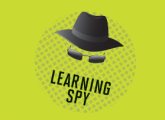Spatial thinking is acknowledged by psychologists as a key element of ‘general ability’, one of the basic mental tools we all have and need to use. However, many children are either unaware that they have a strength in this basic mental ability or it has been dismissed as merely them being ‘good with their hands’ or ‘gifted at art’. Research has shown that spatial learners often flourish in science, technology, engineering and mathematics (STEM), and that developing young people’s spatial thinking can increase achievement in these important subjects.
“My school years were vile, violent and humiliating,” declares Mark Wilkinson OBE OLM. “I was in the D-stream in a secondary modern school, where I would get lost in all of the words the teachers used and, if I hadn’t bunked off for the day, I’d spend my time staring through the classroom window, changing the scene outside with imagined images that built into pictures inside my head. It was only when I discovered that I had an innate ability to imagine and make beautiful objects in the craft class that my life changed.”
Mark Wilkinson is a modern day spatial thinker. Despite the trauma of his school years, he is widely recognised as this century’s leading designer of fine British furniture. He is also a member of Mensa. His story is typical of many children who pass through an education system that tends to favour the type of intelligence most naturally displayed in writing and language-based tasks.
What is a spatial thinker?
A spatial thinker is simply someone who thinks most easily by using images and only afterwards converts these thoughts to words; an individual with a capacity for mentally generating and transforming visual images. According to Dr Jonathan Wai, psychologist and research scientist at Duke University, North Carolina, schools are neglecting such learners for three main reasons:
Most teachers do not have a spatial ability bias. Alex Knapp, of Forbes Magazine, has suggested that those drawn to education are those most comfortable with verbal thinking. This is not surprising, given that oral communication is a key element of teaching. Thus teachers identify with students who have similar strengths to their own and find it difficult to appreciate that others have very different strengths and weaknesses.
Spatially talented people are not very vocal. Both Edison and Einstein were spatial thinkers, known to be poor talkers who spoke rarely and even then with much hesitation. As those who have a high spatial ability tend to be less vocally fluent, there is a suggestion that they are less likely to verbalise their dissatisfaction with the school system.
Standardised tests conducted in schools do not typically include spatial measures. Therefore, if schools are not testing for spatial ability, then they are less likely to pay it adequate attention.
The case for spatial thinking
Research has shown how neglecting spatial abilities could have widespread consequences. There is evidence that those with relatively strong spatial abilities tend to gravitate towards and excel in fields such as physical sciences, engineering, maths and computer science, as well as art and design. Nora Newcombe, Professor of Psychology at Temple University, Philadelphia, explains that numerous studies indicate spatial thinking is central to STEM success. She identifies Project Talent as one of the most important. The study followed approximately 400,000 American pupils over a 50-year period. It found that those who had high scores on spatial tests in high school were much more likely to major in STEM disciplines and go into STEM careers than those with lower scores. Professor Newcombe points out that spatial thinking is not a substitute for verbal thinking. Nor is it a learning style. She believes instead that teachers should be trying to provide students with content knowledge, experiences and skills that support development of both verbal and spatial thinking.
The significance of STEM
Professor Sir John Gurdon was ranked last in his Eton year group at biology and was in the bottom set in every other science subject. Yet 64 years later he has been awarded the Nobel Prize in medicine. His inability to cope with the rote-learning demands of post-war school science suggests he may be a spatial thinker and his example demonstrates what potential we risk losing by not supporting our spatial learners.
Business leaders are pointing to a shortage of scientists and mathematicians in industry. Earlier this year, Nigel Whitehead, group managing director of BAE Systems, revealed that just ten per cent of people in the UK study STEM subjects beyond the age of 16. He warned of a looming crisis with 60 per cent of UK jobs over the next decade requiring STEM skills, and called for outreach programmes to be adopted by businesses, for parents to be educated as to the importance of STEM, and the use of social media to redress the STEM imbalance. Another essential element to improving the take up of STEM subjects is identifying spatial thinkers early and tapping into their talents.
Ormiston Forge Academy is a progressive inner city school. Andrew Burns is its forward-thinking principal in the midst of a far-reaching programme to transform the school’s approach to teaching and learning. He recently introduced the Cognitive Abilities Test (CAT) for Year 7 students to allow teachers to gain a measure of pupil capacity, what they can do, how they work and also their strengths and weaknesses. Teachers are now able to easily differentiate between the abilities of individual pupils. There has been a noticeable improvement in social skills and the self-esteem of pupils as a result. The test is about to be rolled out to Year Eight and Year Nine pupils, allowing teachers to identify spatial learners and provide assistance to those gifted in STEM subjects.
We need all schools to follow the path set by Ormiston Forge Academy and others like them in understanding that learning should be tailored to the individual. As a society it is important that we change the way intelligence is defined by schools, parents and our culture in general. We also need to identify spatial learners early. By making spatial learning more explicit, educators can appreciate when and how it takes place.
What can you do?
• Consider introducing a means of identifying spatial learners.
• Find out what subjects children find easy or hard and make sure they are aware of their own learning profile.
• Explain which techniques work better for spatial learners and which ones work for verbal learners so pupils can choose how they do a task and do not suggest there is only one approach that is ‘correct’.
• Do not assume that the way you think and what you find easy or hard will be matched by pupils. An inarticulate, low-achieving child may complete intellectual tasks of a spatial nature that you find difficult, with great ease.
• Encourage children to try to develop their weaker areas, as it will help them cope with life and work more effectively.
• Ensure they know the implications of strengths in particular types of thinking for likely success in different career areas and disciplines. Good spatial thinking may imply a potential for maths, physics, architecture or engineering, not just construction trades and art.
• Encourage children to look at subjects and careers beyond gender-stereotyped ones, as much spatial potential is currently wasted in girls and verbal potential in boys. Some 25 per cent of extreme spatial thinkers are girls and 40 per cent of extreme verbal thinkers are boys.
Info bar
Cognitive abilities test (cat) was established over 30 years ago and is currently used by schools to identify students’ strengths, weaknesses and learning preferences through a series of verbal, non-verbal and quantitative tasks. The new edition of the test, cat4, contains a greater emphasis on uncovering spatial learners and is available for children aged seven – 16 years. the tests are available in both paper and digital format. For more information, visit: www.gl-assessment.co.uk/cat4
About the expert
Pauline Smith is senior psychometric consultant and developer of the cat4 tests at GL Assessment










